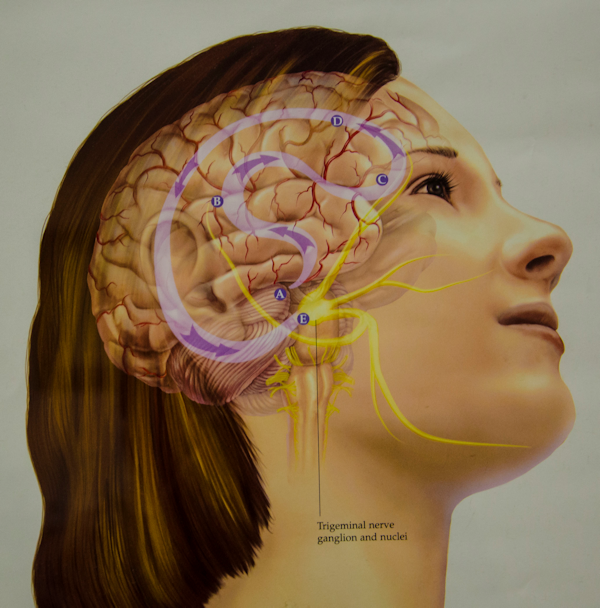
What Is a Migraine?
A migraine is a recurring moderate to severe headache. The pain usually occurs on one side of the head. It is typically a throbbing pain. Migraine is a biological disorder of the brain. While it is more common in women, it can affect anyone. It usually begins in childhood, adolescence, or young adulthood.
What Causes Migraine?
The exact cause of migraine is unknown. It appears to be an inherited biochemical disorder in the brain. People with migraine may have a more sensitive nervous system response than others. During an attack, changes in the brain activity may cause blood vessels and nerves around the brain to become irritated and inflamed.
What Are the Symptoms?
Symptoms vary greatly among people with migraine but can include:
- Moderate to severe headache that lasts 4 to 72 hours, if untreated
- Throbbing pain, often on one side of the head
- Increased pain after exercise or movement
- Sensitivity to bright light, sound, and/or odors
- Nausea and/or vomiting with the headache
One in five people with migraine have a warning before the headache. This is called an aura. An aura may consist of flashing lights, temporary loss of sight, or numbness on one side of the body. In some cases, people experience the aura without an accompanying headache.
How is Migraine Diagnosed?
No medical test can confirm that you have migraine. You will need to provide details about your headaches and your symptoms to your neurologist or primary care physician. Your physician will also perform a neurologic examination to check the functioning of your nervous system. Often, no further testing is needed. If your symptoms do not fit a typical pattern for migraine, your physician might order brain imaging or other tests.
What Are the Treatment Options?
Although there is no cure, migraine is treatable with proper medical care and self-management that:
- Identifies and controls triggers that start a migraine
- Uses medications to treat migraine attacks acutely
- Uses medications and other treatments to help prevent attacks
- Encourages healthy behavior and lifestyle changes.
Keeping a headache diary is a valuable tool for treating migraine. In it, you can note your pain level, symptoms, possible triggers, and treatments. Many migraine diary examples are available online. A diary can help you work with your neurologist to track how well drugs are working.
Acute Migraine Treatments
Acute migraine treatments are used to stop an attack when it occurs and treat its symptoms. Two types of acute treatments are available: drugs that specifically stop the migraine, called abortive treatments, and nonspecific pain relievers.
Migraine-specific abortive treatments include:
- Prescription migraine drugs such as triptans (example, sumatriptan) and ergot alkaloids (example, dihydroergotamine [DHE])
Pain-relieving drugs include:
- Nonprescription (over-the-counter) nonsteroidal anti-inflammatory drugs, such as ibuprofen, and analgesics, such as aspirin, acetaminophen, or a drug that combines acetaminophen with aspirin and caffeine
- Prescription nonsteroidal anti-inflammatory drugs and analgesics
It is very important to take these medications as close to the start of the headache as possible. Acute treatments do not work as well several hours into a headache. Most of these acute treatments are designed to be used infrequently. If you find that you are using acute therapies more than one to two times per week, you should talk to your neurologist about alternative approaches.
Anti-nausea drugs are also frequently used to treat the nausea that accompanies migraine, and they may have some effect on the headache itself.
Preventive Treatments
Daily preventive medications are available for people with frequent, severe, debilitating migraines. They can also help if your treatment is not working or is causing side effects. They include:
- Tricyclic antidepressants
- Beta-blockers
- Calcium channel blockers, such as verapamil
- Some anticonvulsants
- Nonsteroidal anti-inflammatory drugs
- Alternative treatments, such as vitamin B2, magnesium, and feverfew
Talk to your neurologist about when you can expect the treatment to work, also if your treatment is not working or if you are overusing acute medications to stop migraine attacks. Overuse of acute drugs can lead to more frequent headaches.
Cognitive and Behavioral Treatments
Research has shown that some cognitive and behavioral treatments can help prevent migraine. Such treatments include:
- Relaxation training
- Thermal biofeedback with relaxation training
- Electromyographic (EMG) biofeedback
- Cognitive and behavior therapy (also called stress management training)
Living with Migraine
The following practices and tips can help reduce the impact migraine has on your life.
Know and Avoid Migraine Triggers
Triggers vary from person to person. Some triggers are avoidable, but many are not. They can include:
- Diet: Missed meals, alcohol, foods with monosodium glutamate (MSG), too much caffeine or withdrawal from caffeine, and preserved meats with nitrates and nitrites
- Sleep: Too much or too little sleep
- Stress: Stress and release from stress
- Hormones: Changes during the menstrual cycle
- Environmental factors: Weather changes, bright or glaring lights, strong odors, and high altitude
You will have the best results by taking these steps:
- Work with your neurologist to develop a treatment plan
- If your headaches are bad enough, talk to your neurologist about prevention
- Be actively involved in your treatment, including keeping a headache diary
Resource: American Academy of Neurology
